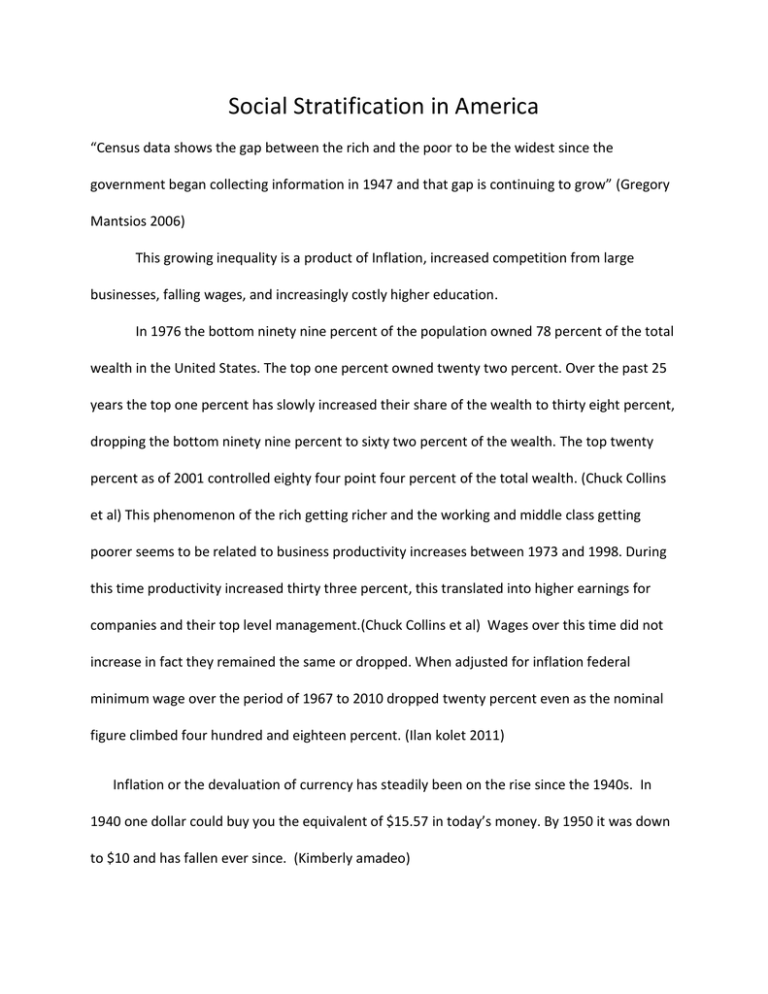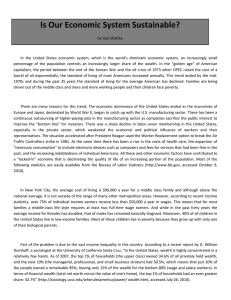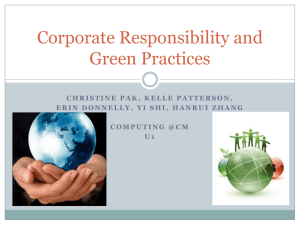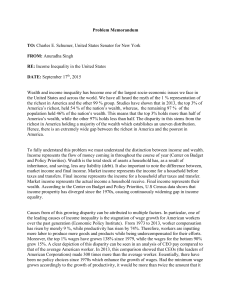2. Class in America 2006 by Gregory mantsios.
advertisement

Social Stratification in America “Census data shows the gap between the rich and the poor to be the widest since the government began collecting information in 1947 and that gap is continuing to grow” (Gregory Mantsios 2006) This growing inequality is a product of Inflation, increased competition from large businesses, falling wages, and increasingly costly higher education. In 1976 the bottom ninety nine percent of the population owned 78 percent of the total wealth in the United States. The top one percent owned twenty two percent. Over the past 25 years the top one percent has slowly increased their share of the wealth to thirty eight percent, dropping the bottom ninety nine percent to sixty two percent of the wealth. The top twenty percent as of 2001 controlled eighty four point four percent of the total wealth. (Chuck Collins et al) This phenomenon of the rich getting richer and the working and middle class getting poorer seems to be related to business productivity increases between 1973 and 1998. During this time productivity increased thirty three percent, this translated into higher earnings for companies and their top level management.(Chuck Collins et al) Wages over this time did not increase in fact they remained the same or dropped. When adjusted for inflation federal minimum wage over the period of 1967 to 2010 dropped twenty percent even as the nominal figure climbed four hundred and eighteen percent. (Ilan kolet 2011) Inflation or the devaluation of currency has steadily been on the rise since the 1940s. In 1940 one dollar could buy you the equivalent of $15.57 in today’s money. By 1950 it was down to $10 and has fallen ever since. (Kimberly amadeo) 1960 = $7.67 1970 = $5.62 1980 = $2.65 1990 = $1.67 2000 = $1.27. As the United States dollar has been devalued minimum wage has lagged behind. This creates a huge problem especially for the working class because suddenly their labor is not worth as much as it used to. Because of this they can’t afford to live the same quality of life. This has gotten progressively worse over the years and in my opinion it should be the federal government’s responsibility to raise minimum wage at the same rate they devalue our currency. After all inflation is their fault for spending such exuberant amounts of money. The arise of national and multinational corporations has had a huge impact on the concentration of wealth and its shift from the lower and middle to the upper class. According to one of my older college professors, when he first came to America a lot of the businesses were family owned and operated but over the years he has seen a dramatic shift from family owned businesses to national and multinational corporations taking over. He thinks this is a result of family owned businesses not being able to compete against the corporations and I have to agree with him. Just imagine trying to open up a hardware store, pharmacy, or grocery store in modern America it would be nearly impossible to do so because almost all of the space in those industries is filled up by large corporations and there is almost no way you can compete. This trend of large corporations taking over entire industries has taken wealth away from the masses of small business owners by putting them out of business and now that money is being concentrated in corporate head honchos pockets. Falling wages mean to a lot of Americans more work time and less time to be involved with education, family, leisure, service, etc. This can lead to negative consequences on the individual and the family. For the individual or I know at least for me, more work time equates to more stress higher rates of illness and a diminished quality of life. For a lot of American families falling wages mean mom and dad both have to work this equates to less time for the parents to focus on the well being of the family and their children’s education. This can have some very negative results on families. The rising cost of college means fewer people can afford higher education. This means fewer people will be able to attain the training and credentials necessary to get higher paying jobs thus contributing to the growing inequality. The cost of college has risen to the point where many seek out student loans to pay for higher education. In 1991 the average student debt was $8200. By 2003 the average student debt had risen to 18900. (Chuck Collins) This rising student debt means many students will still be paying off student loans in their mid thirties. Inflation is on the rise. Wages are lagging behind. College costs more than ever. Corporations are taking over the business world and pushing small business out. All of this is contributing to the growing inequality in America. Bibliography: 1. The Dangerous Consequences of Growing Inequality. by chuck colllins, fellice yeskel, with united for a fair economy and class action. 2. Class in America 2006 by Gregory mantsios. 3. What Is the Value Of a Dollar Today? By Kimberly Amadeo 4. Minimum Wage in U.S. Fails to Beat Inflation: Chart of the Day By Ilan Kolet and Bob Willis










